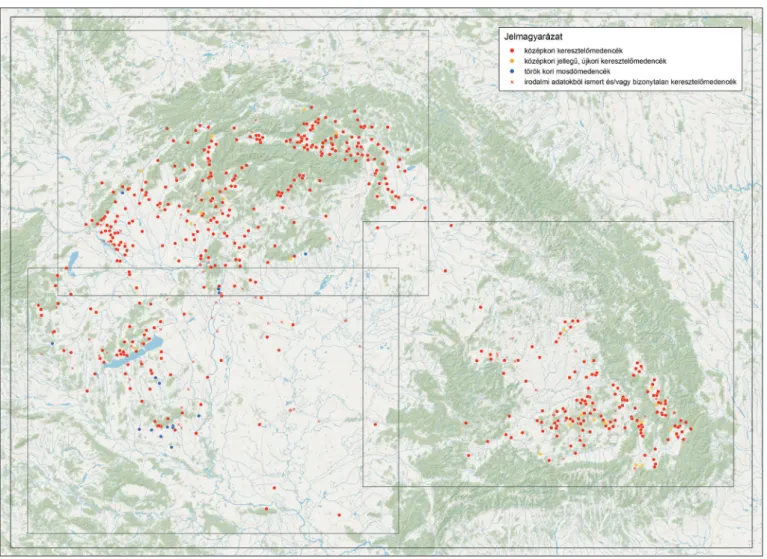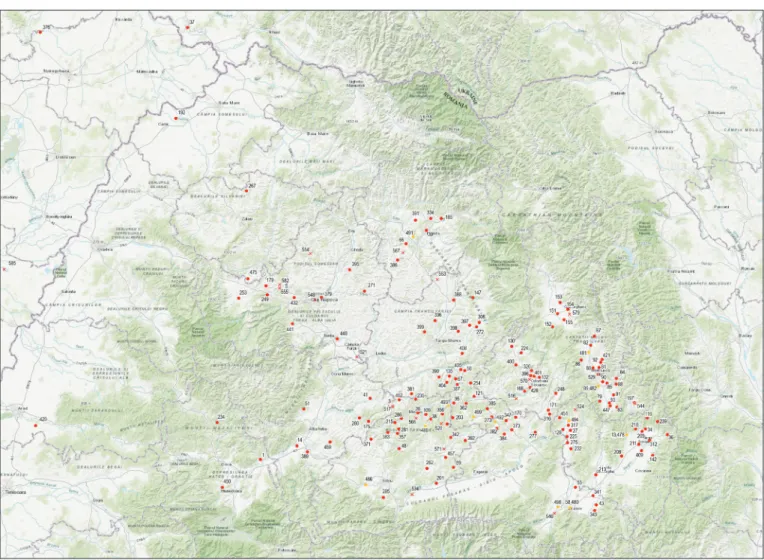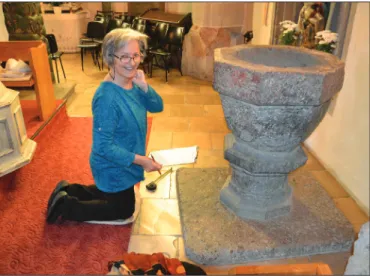EDIT TARI: LITURGY CARVED IN STONE [Hungarian book].
Medieval Stone Baptismal Fonts from the Carpathian Basin
Pál lôvei
The history of science behind Edit Tari’s monumental volume dates back one and a half century. The idea of an art history corpus engendered in Hungary during the second half of the 19th century based on the historic programme of positivism,1 which in contrast to patri- cian romanticism, relied on exact knowledge and facts.
Ernő Marosi correlated the corpus collection created by addition of data and details with the notion of scat- tered remains of animate? inanimate? body parts (dis- jecta membra),2 according to the leastwise one and a half century old realization that past products of Hun- garian art can and should solely be collected through ardous work due to vast devastation and dispersion.
The programme for collecting scattered body parts, tumbled monuments was announced by the renowned triad of Hungarian art history and archaeology from the 1860s. Arnold Ipolyi established corpus-related tasks in a series of academic presentations centered on deal- ing with Medieval architecture, sculpture and painting.3 Flóris Rómer undertook enumerating antique murals.4 His already „foraging” way of life granted him the possbility to compile a significant bell inventory which however, he never got around to publish. His protu- berant paddled copies of decorations and inscriptions made with wetted paper and copies made with graph- ite shading were conserved in his inheritance.5 Imre Henszlmann published a registry of Medieval archi- tectural monuments which simultaneously categorized the very monuments.6
It was expressed early on by Ipolyi that baptismal fonts and holy water stoops cannot always be univo-
cally distinguished from one another. In the church of Csallóközcsütörtök (Štvrtok na Ostrove, Slovakia) the present volume describes two conserved basins, the earlier one has been walled in and is presently utilized today as a stoop. On Almakerék (Mălâncrav, Romania) the catalogue contains a basin known only from photograph, a fragmentary carving and second intact basin that serves curretly as a stoop. At Csíkrákos
1 R. VáRkonyi 1973a, 19.; 1973b 50–56.
2 MaRosi 2010, 345.; Cf. referring to the organism, the living body: MaRosi 2009, 9.
3 Most recent edition: ipolyi 1997.
4 RóMeR 1874.
5 The inheritance of Flóris Rómer. MÉM–MDK: Hungarian Museum of Architecture – Documentation Center of Monument Protection, Scientific Records.
6 HenszlMann 1885; 1886 1887.
Edit Tari: Liturgy Carved in Stone [Hungarian book]. Medieval Stone Baptismal Fonts
from the Carpathian Basin, Hungarian National Museum,
Budapest, 2018.
396 pages
(Racu, Romania) a deteriorating stoop is stood next to the basin, same as at Csíkszentdomokos (Sândomi- nic, Romania), where there is an additional stooped walled in, which was only included in the present vol- ume as a mention and a photograph, but not a separate catalgoue entry. At Csíkszentgyörgy (Ciucsângeor- giu, Romania) specimen of both carving types is present. The minuscule carved work at Bodrog-Berek is univocally a stoop, the one at Buzsák is joined to the wall even today.
Generations following Ipolyi, Rómer and Henszlmann concentrated their research on the art geographic and monumental topographic aspects of the founding triad, which was well established in their work and programme, returning mainly to Ipolyi’s tradition during the middle of the 20th century. In accordance with historic accuracy, all work conducted at that time viewed and collected material in perspective of the con- temporary Hungarian Kingdom, technically all of the Carpathian Basin. Among recent publications, the bell catalogue of Pál Patay was limited to present-day Hungary,7 while Elek Benkő published a monumental corpus of Medieval bells and bronze baptismal fonts from Transylvania.8 The important inventory of Kinga German catalogueing Medieval tabernacles also covers the area of Transylvania.9
Half a century after the extensive catalogue volumes realized in the 1950s and 1960s, Edit Tari is the respectable pursuer of corpus tradition following the renowned forerunners of the 19th century. The pres- ent carefully elaborated volume of 400 pages in A4 format is the output of more than three decades of occasionally interrupted collecting and processing. Figure 3 It is a corpus indeed, a genuine collection of
„approximately 600 stone and a dozen wooden baptismal fonts (and in a minor part, holy water stoops as briefly discussed above) that survived in ca. 4300 Medieval parishes”. The author borrowed the fitting title, „Liturgy Carved in Stone” from László Zolnay, who penned it in relation to the baptismal font of Selmecbánya (Banská Štiavnica, Slovakia) recorded during the collection of monuments decorated with snagged branches.10
Edit Tari did not undertake the inclusion of bronze baptismal fonts, which is justified. However, it would have been appropriate to list them at least in an annex beacuse of their same liturgic role, although they were made using a completely different, fine and expensive material and related techniques attest a differ- ent financial background and different level of taste. As expressed in the introduction, seven items from Transylvania have been recorded by Elek Benkő.11 Similar specimen from Szepes and Sáros counties were collected by Mária Vérő in her dissertation.12 She published her results with the catalogue of 18 items in an extensive article in 2002.13 Including the bronze baptismal fonts from Pozsony (Bratislava, Slovakia), Kassa (Košice, Slovakia) and Besztercebánya (Banská Bystrica, Slovakia) the list enumerates 30 records, which could complement the catalogue of Edit Tari’s quantitative database.
Based on a consultation with Beatrix F. Romhányi, the author estimated the number of municipal, rural and monastic churches granted with parish rights for baptism at the beginning of the 14th century to ca.
4000-4300. The latter number indicates that few new churches were constructed until the end of the Middle Ages and most were reconstructions or renewals of earlier edifices. One can reckon a single baptismal basin was used in all such churches and most did not have two at the same time. On one hand, already the Roman- esque ones were used for centuries, some are still used today, surviving the demolition and reconstruction of their original church. On the other hand later ages tended towards creating pseudo-archaic pieces. Thus the 650 records including bronze ones, regardless that not all records are baptismal basins as they include holy water stoops too, make up for a considerable proportion (15% according to the comments on the maps)14 of the presumed total, contrary to Medieval epitaphs of which only 1-2% survived.
7 patay [1989].
8 Benkő 2002.
9 GeRMan 2014.
10 See taRi 2018, 6. and 59.
11 Benkő 2002, 85–101, 377–421.
12 Verő 1984.
13 Verő 2002.
14 See taRi 2018, 339.
Conservativism of the genre is the reason that the temporal upper bound of the collection can hardly be determined. Before even beginning the catalogue itself, the author published unique specimen in smaller subsets. Thus merely a list on pieces secondarily recarved from architectural features, column heads, capstones was edited into the main text. Incidentally this may be complemented with a greyish white marble piece, recarved from a 13th century column head currently located in the parish church of Pornóapáti in Vas county, which plausibly originated from the former Cistercian abbey at Pornó.15 Con- verted Turkish washbasins form another group comprised of approx. 20 specimen, which were organized into „proper” catalogue records complete with photos and drawings. The chapter on wooden baptismal fonts includes 16 records, a result of „subjective selection” as attested by the author herself and although it may not be so for the field of Anthropology, but for me and the Hungarian discipline of art history this section is a complete novelty. Of the considerably higher number of carvings known to her, Edit Tari complemented her High Medieval collection with archaic, medievalistic specimen, the latest of which could be of an 18th century date. Ten lavabo, hand-basins or fonts placed either in chancel or sacristy, form a separate subchapter.
The main inventory constitutes more than half of the volume. The reader may also encounter rather early Romanesque carvings from the 12th and 13th centuries. Many specimen display the quite homogenous decorative style of the Gothic and a few Renaissance artwork from the time of King Matthias I of Hungary and the Jagellonian era. The following carvings, dated respectively to 1604, 1639, 1646, 1653, 1658, 1663, 1666, 1670 and 1709, some of which convey a genuinely Medieval way of thinking and further undated specimen that are also marked „Medievalistic” all reflect the above-mentioned conservativism. The author
15 zsáMbéky–HajMási–iVicsics 2002, 146, 150. (Cat. Nr. 74.4.); fig. 607–610.
Figure 1: The distribution of Medieval baptismal fonts in the Carpathian Basin
proposes that a subset of inscriptions may have been chiseled or etched in later on. Some pages display photos of 20th century carvings.
Basins lost and known solely from accounts and fragments with uncertain interpretation range to more than seventy items. It was not possible for the author to confirm these fragments.
The last subchapter of the inventory is titled „Drawings in records” and essentially compares the drawn surveys on baptismal fonts published by drawing-master Viktor Myskovszky and the ones made during the golden age of Hungarian heritage protection in the second half of the 19th century and kept in plan archives, with photos taken of the same fonts. It revealed that the aesthetic qualities of the drawings were preferred over accuracy and proportions as details occasionally deviate considerably from reality.
The flyleaves of the volume contain a map of the Carpathian Basin with tiny signs marking the geo- graphical distribution of baptismal fonts. The back contains the legend and a delineation of the three map subsctions included at the end of the volume enlarged to fit double pages that contain relevant locations marked with sequential numbering: as seen before these 588 settlements indicate more than 600 specimen.
Figure 1 Another double page map of the Carpathian Basin displays different era and style groups with separate colors. A map of considerably smaller scale presents the topography of basins decorated with trac- ery, and another one displays along with specimen from the Carpathian Basin the 24 locations on German, Austrian and Czech territories where Late Gothic basins decorated with snagged branches were recovered to the author’s knowledge.
Edit Tari interpreted the material she collected. Following a national and a European research history, she presents liturgic context both commenting the title and giving the utility background of the objects.
It is followed by a typological classification generalized from shaping and a subsequent presentation of
Figure 2: Medieval baptismal fonts in Transylvania with typology
characteristic decorations (cross, coat of arms, date and inscription, portrayal, Agnus Dei, floral and geometric ornaments, knot braided ornaments, trac- ery and snagged branches) and the specimen that display these ornaments. The stylistic interpretation of snagged branches is based on the article of László Zolnay that placed the finds of his excavation at Buda in context.16
The section titled „Medieval stonemason work- shops” on logistics, mining and stonework design related questions in truly important. Regarding the latter, the system of design lines observed on the base plane of a fragmented baptismal font recovered from Gábor Wilhelm’s excavation at Felsőalpár–
Lakitelek constitutes an extraordinary Hungarian find. This is not the only recent archaeological find in the catalogue, the names of more than 140 archae-
ologists, art historians, architects, restorers from both Hungary and abroad listed after the introduction who furthered Edit Tari’s work in any way signify an impressive social network.
Finally the introductory essay is concluded with the uncovering of possible workshop linkage and the recognition of a few convincing connections. It is small wonder that this yielded mostly cohesive groups comprised of carefully preserved baptismal fonts of neighbouring or nearby villages on rather isolated and conservative borderlands, e.g. the Romanesque pieces in southeast Transylvania or the Late Gothic carvings in Liptó. Figure 2 Edit Tari discovered South Scandinavian, Swedish parallels to the horizontally interlinked Romanesque friezes made of heart shaped leafs of Transylvanian specimen.
The introduction states that such a work is never finished and hopefully it will be continued on an online surface complete with future data. Thus there is yet work to be done, but now however, the author may lean back a little, she delivered a respectable volume recommended for all.17
biblioGRapHy
Benkő, elek 2002:
Erdély középkori harangjai és bronz keresztelőmedencéi. Budapest–Kolozsvár.
GeRMan, kinGa 2014:
Sakramentnischen und Sakramentshäuser in Siebenbürgen. Die Verehrung des Corpus Christi. Petersberg.
HenszlMann, iMRe 1885:
Honi műemlékeink hivatalos osztályozása I–III. Archaeologiai Értesítő (Budapest) Ú. F. 5, xvi–xxiii, xxvii–xxx, xxxvi–xl.
—— 1886:
Honi műemlékeink hivatalos osztályozása IV–V. Archaeologiai Értesítő (Budapest) Ú. F. 6, 114–117, 335–337.
16 zolnay 1980, 117–130.
17 A considerably more extensive printed version will be publishd in the Archaeologiai Értesítő [Archaeological Bulletin].
Figure 3: Edit Tari while documenting the baptismal font at Gyöngyöspata
—— 1887:
Honi műemlékeink hivatalos osztályozása VI–VII. Archaeologiai Értesítő (Budapest) Ú. F. 7, 263–267, 349–352.
ipolyi, aRnold 1997:
Tanulmányok a középkori magyar művészetről. [Budapest]
Marosi, ernő 2009:
Magyar(országi) művészettörténet – régiók művészettörténete. In: N. Kis Tímea (főszerk.): Colligite fragmenta! Örökségvédelem Erdélyben. Örökségvédelmi konferencia, Budapest, ELTE 2008. ELTE BTK Művészettörténeti Intézeti Képviselet, Budapest, 9–19.
—— 2010:
[opponensi vélemény] In: Lővei Pál „Posuit hoc monumentum pro aeterna memoria (Bevezető fejezetek a középkori Magyarország síremlékeinek katalógusához)” című akadémiai doktori értekezésének vitája.
Művészettörténeti Értesítő (Budapest) 59, 345–349.
patay, pál [1989]:
Corpvs campanarvm antiqvarvm Hvngariae. Magyarország régi harangjai és harangöntői 1711 előtt.
Magyar Nemzeti Múzeum [Budapest].
RóMeR, FlóRis 1874:
Régi falképek Magyarországon. (Monumenta Hungariae Archaeologica – Magyarországi Régészeti Emlékek III/I.) Budapest.
taRi edit 2018:
Kőbe faragott liturgia. A Kárpát-medence középkori kő keresztelőmedencéi. Budapest R. VáRkonyi, áGnes 1973a:
A pozitivista történetszemlélet a magyar történetírásban I.: A pozitivista történetszemlélet Európában és hazai értékelése 1830–1945. Budapest
—— 1973b:
A pozitivista történetszemlélet a magyar történetírásban II.: A pozitivizmus gyökerei és kibontakozása Magyarországon 1830–1860. Budapest.
Verő, Mária 1984:
Adatok a magyarországi bronzművesség történetéhez. Későközépkori keresztelőkutak a Szepességben és Sárosban. Szakdolgozat, ELTE BTK Művészettörténeti Tanszék, Budapest.
—— 2002:
Spätmittelalterliche Erztaufbecken in Nordungarn: in der Zips und in Bartfeld. Acta Historiae Artium (Budapest) 43, 113–190.
zolnay lászló 1980:
Csonkolt faágas motívumok későgótikus épületplasztikáinkban. Művészettörténeti Értesítő (Budapest) 29, 117–130.
zsáMbéky, Monika – HajMási, eRika – iVicsics, péteR 2002:
Pornóapáti, egykori pornói ciszterci apátság. In: Lővei Pál (szerk.): Lapidarium Hungaricum. Magyarország építészeti töredékeinek gyűjteménye 6. Vas megye II. Vas megye műemlékeinek töredékei 2. Magyarszecsőd – Zsennye. Budapest. 146, 150. (74.4. kat. sz.); 607–610. kép


